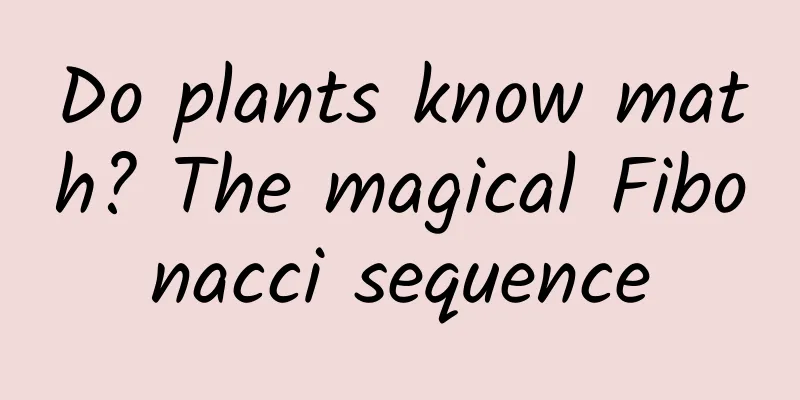Do plants know math? The magical Fibonacci sequence

|
Editor's note: Plants occupy a very important position in nature. With the passage of time, climate change, geological movement, and habitat changes, plants have remained evergreen and have maintained endless vitality in their continuous evolution. Voice of the Chinese Academy of Sciences and Wuhan Botanical Garden of the Chinese Academy of Sciences jointly opened "Fragrant Grass", where we focus on the survival, competition, reproduction, and death of plants, show the wonders of nature, explore the magical secrets of life, understand the infinite beauty that plants bring to humans, and pay tribute to this silent and flourishing plant world. ▲The beauty of mathematics in plants Image source: ScienceNet Plants and mathematics seem to be two unrelated research fields, but how can they be related? This question requires science to answer us. Through long-term observation and analysis, scientific researchers have surprisingly discovered that the growth of various plants in nature conforms to certain mathematical laws in some aspects. The petals are symmetrically arranged on the edge of the receptacle, and the entire flower is almost perfectly radially symmetrical. The seeds of some plants are round, some are thorn-shaped, and some are light umbrella-shaped... All of this shows us many beautiful mathematical models. Not only that, scientists have also found that the number of petals, sepals, fruits and other characteristics of some plants are very consistent with a peculiar number sequence, one of the most famous number sequences in the world - the Fibonacci sequence: 1, 2, 3, 5, 8, 13, 21, 34, 55, 89... The origin of Fibonacci numbers In the 13th century, the famous Italian mathematician Fibonacci added a rabbit reproduction problem in the revised version of his book "The Abacus Book". The problem is roughly like this: if each pair of rabbits (one male and one female) can reproduce a pair of rabbits every month (assuming it is also one male and one female, the same below), each pair of rabbits has no reproductive ability in the first month, but can reproduce a pair of rabbits every month from the second month onwards. Assuming that none of these rabbits die, how many pairs of rabbits will there be after 12 months starting from the first pair of newly born rabbits? The explanation is: First month: only one pair of rabbits; second month: still only one pair of rabbits; third month: the pair of rabbits reproduced a pair of rabbits, a total of 1+1=2 pairs of rabbits. Fourth month: the original pair of rabbits reproduced another pair of rabbits, a total of 2+1=3 pairs of rabbits. The logarithms of rabbits from the first month to the twelfth month are: 1, 1, 2, 3, 5, 8, 13, 21, 34, 55, 89, 144, ... In order to commemorate Fibonacci, who proposed the rabbit breeding problem, later generations called this rabbit sequence the Fibonacci sequence, that is, the sequence of 1, 1, 2, 3, 5, 8, 13, 21, 34... is called the Fibonacci sequence. This sequence has a very obvious feature, the 0th term is 0, the 1st term is the first 1, and each number in the sequence starting from the 2nd term is the sum of the previous two terms. Interestingly, as the value of the sequence increases, the ratio of the previous term to the next term gets closer and closer to the golden ratio value of 0.618... Therefore, the Fibonacci sequence is also called the golden ratio sequence. Any number in the Fibonacci sequence is called a Fibonacci number. These properties of the Fibonacci sequence are manifested in various forms in nature. There are many different plants in nature. You may not have noticed it, but in fact, some plants' flowers, leaves, and fruits contain Fibonacci numbers. Fibonacci Sequence of Seeds and Flowers Open the door to the plant kingdom, and you will find that the arrangement of flowers in the sunflower disk is not chaotic, but hides the beauty of mathematical logic! The tubular flowers and seeds in the center of the sunflower inflorescence are arranged from the center point to the outside, and the number of each circle is 1, 2, 3, 5, 8, 13, 21, 34, 55, 89, 144, 233... according to the law of the Fibonacci sequence, that is, the latter number is the sum of the previous two numbers. You can also see the spiral lines extending from the center point to the periphery. In the inflorescence filled with 300 tubular flowers, there are 34 left-handed curves and 21 right-handed curves, and the total number of spiral lines is the Fibonacci number. Why are sunflowers arranged like this? It turns out that sunflowers need to breed as many offspring as possible and produce more fruits, so they must "consider" the economy of space. The sunflower inflorescence arranges as many small tubular flowers as possible together to enhance the attractiveness of the "small flower group". At the same time, it is also necessary to reduce mutual interference between the small flowers. The less overlap between the small flowers, the better, to ensure that the small flowers have equal space. The mathematical arrangement of sunflowers can accommodate the largest number of seeds in the same area, the flower disk becomes the strongest and the chance of producing offspring is also the highest. ▲Fibonacci sequence in the sunflower disk Image source: researchgate.net Common Asteraceae plants, such as Argyranthemum frutescens and Echinacea purpurea, have Fibonacci spirals on their flower disks, and the larger the flower disk, the more obvious it is. Sunflower is just a typical example. The reason why the flower disk of a plant shows Fibonacci spirals is that such an arrangement allows the seeds to be best stacked, with similar growth spaces, which can make full use of sunlight and air, and is conducive to the reproduction of future generations. The arrangement of pine nuts on pine cones also follows the Fibonacci spiral. When you look closely at the pine cone, you can observe the spiral pattern of the arrangement, and each pine cone scale will extend outward along its own set of spiral curves. ▲Fibonacci sequence in pine cones Image source: fjjyxy.com & sciencealert.com Fibonacci sequence of tree leaves During the growth process of trees, new branches often need to "rest" for a period of time to absorb and store more nutrients for their own growth before new branches can sprout. Therefore, a sapling grows a new branch after a period of time, such as one year; the new branch "rests" in the second year, and the old branch still sprouts; thereafter, the old branch sprouts at the same time as the branch that "rested" for a year, and the new branch that grew that year "rests" the next year. In this way, the number of branches of a tree in each year constitutes the Fibonacci sequence. In other words, the way branches reproduce is to grow according to the Fibonacci sequence. According to this arrangement pattern, the leaves can obtain as much sunlight as possible for photosynthesis, or receive as much rain as possible to irrigate the roots. For this reason, architects have designed and built new bionic houses based on the arrangement of plant leaves on stems. Not only are they novel, unique, beautiful, and generous in appearance, they also have excellent ventilation and lighting performance, highlighting the wonderful use of the golden ratio. We know that the horn-like water chestnuts eaten in summer and autumn come from water chestnuts. Water chestnut plants are commonly found in water bodies such as ponds, rivers and swamps. Its fruits have hard shells like horns but are delicious. Take a close look at the leaves floating on the water. Are they very special? The leaves are arranged in a spiral shape, and the number of leaves on each spiral follows the Fibonacci sequence, that is, 1, 2, 3, 5, 8, 13... If you don't believe it, you can count them. Do water chestnuts understand the Fibonacci sequence? In fact, this is not the case. They just evolved like this according to the laws of nature. Each leaf grows out from the central axis. In order to make the best use of space during the growth process (considering that the leaves grow gradually one by one, not all at once), there should be a suitable angle between each leaf and the previous leaf. The spiral arrangement ensures that the leaves do not block each other and cover the water surface, which is conducive to the growth of water chestnuts. Isn't it interesting? ▲Water chestnut fruit picture source: quanjing.com ▲Fibonacci sequence of water chestnut leaves Image source: zhiwusuo.com In addition, there is a certain relationship between the number of leaf divisions and the Fibonacci sequence. For example, the leaves of the two-lobed palm and Bauhinia have two lobes, the leaves of morning glory and grapes have three lobes, the leaves of Acer truncatum and Acer palmatum have five lobes, and the leaves of Aglaonema sempervivum mostly have eight lobes. ▲Fibonacci sequence in leaf crack number Image source: Flora of China Fibonacci sequence of flower petals If we observe carefully, we can find that in nature, there are anthuriums and morning glories with 1 petal, begonias and tiger thorns with 2 petals, and tillandsias and bougainvilleas with 3 petals. The most common number of petals is 5. Peach blossoms and plum blossoms have 5 petals, irises and lilies (which look like 6 petals, but are actually two sets of 3 petals) have 3 petals, and there are delphiniums and cosmos with 8 petals, cinerarias and marigolds with 13 petals, and aster with 21 petals. Some sunflowers have 21 petals, some have 34 petals, and most daisies have 34, 55 or 89 petals. These numbers of petals are very common in the plant world, while other numbers are relatively rare. If these numbers are arranged, they are 3, 5, 8, 13, 21, 34, 55.89... Do you find any pattern from them? That is, the sum of the first two of these numbers is equal to the third one, which is also the Fibonacci sequence. ▲Fibonacci sequence in petals Image source: csdn.net In fact, there are many connections between the Fibonacci sequence and nature, life, and science. The Fibonacci sequence is like a smart and graceful musical note, composing the magical and wonderful rhythm of nature with its extremely beautiful and harmonious tune. Moreover, the Fibonacci sequence also fully reflects the beauty of symmetry, strangeness, and unity in mathematics. Surprises are everywhere in life. The Fibonacci sequence in plants is the scientific enlightenment and artistic inspiration that nature brings us in its most unique way, allowing us to feel the harmony of nature and the wonder of the mathematical world. ▲Fibonacci sequence of plants in nature Image source: dashangu.com Source: Wuhan Botanical Garden, Chinese Academy of Sciences Science Communication Research Center of Chinese Academy of Sciences Editor | Li Chun Proofreading | Li Sijin Cao Ruiyue Audit | He Yong |
>>: These drugs are no longer available and have been recalled! Check if you have any
Recommend
What should “friendly competitors” in the war of words learn from Uber?
Last week, two things dominated the WeChat Moment...
I want to poop right after eating. What's the reason?
Not long after eating, the call of the wild from ...
After 8 years, 16 Crested Ibis returned home! Why did they go abroad?
"The graceful crested ibis comes to the spri...
How much does it cost to attract investment for the Lijiang women’s clothing mini program?
How much does it cost to attract investment for t...
Case | Super practical account optimization strategy for the decoration industry
This article shares with you the super practical ...
Will the robot dog "Benben" in "The Wandering Earth 2" appear on the battlefield?
During the Spring Festival this year, the Chinese...
Why did Baidu invest in Uber? Robin Li said it is the only phenomenal Internet company in the United States
The news that Baidu has made a strategic investme...
Introverted personality: Have you “involved” yourself today?
Review expert: Chen Mingxin, national second-leve...
Three departments jointly issued a notice to strengthen the management of in-vehicle audio and video, and network services need to obtain a license
Recently, the Ministry of Industry and Informatio...
How do iQiyi, Youku and Tencent Video monetize advertising?
Most products in the PC era have a clear product ...
The new model of no-car carriers has arrived, and the freight industry has ushered in great development
Not long ago, the Ministry of Transport issued th...
Siri starts to speak human language, voiceprint recognition finally arrives, today's Apple is AI-enabled
Early this morning, the annual Apple WWDC 19 Glob...
WOT2016 Wang Xiuquan: Interpretation of the Difficulties in the Development and Optimization of Mobile Apps
The WOT2016 Mobile Internet Technology Summit wil...
Launched on the three major e-commerce platforms: Luban, Dudian and Maple Leaf!
At this stage, the number of people using smartph...
Geely Borui GE New Energy officially launched, starting at 136,800 yuan
As we all know, our country is now vigorously dev...









